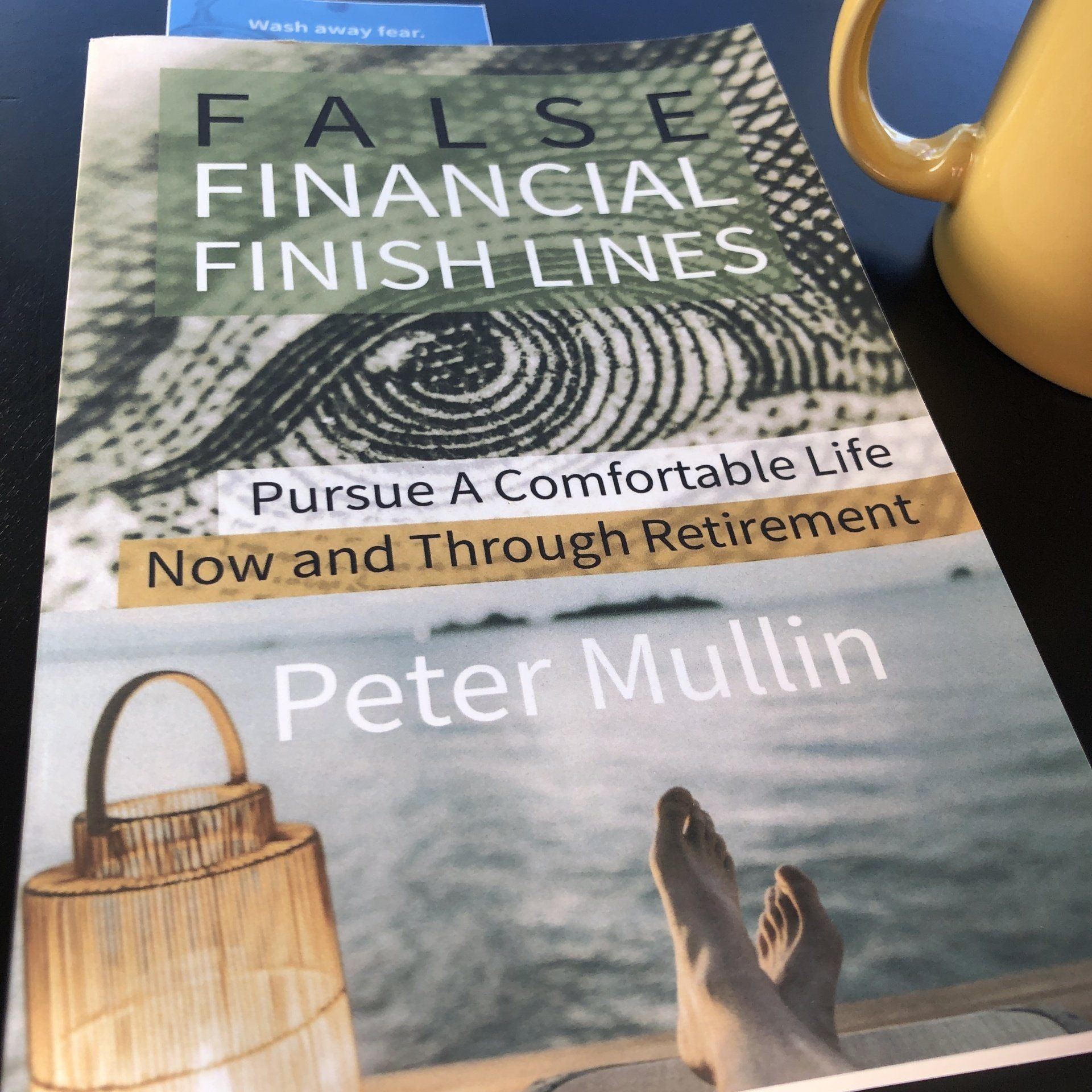Fear is Good
Fear is Good
By Peter Mullin
Investments climb a wall of worry. From November through the start of December 2024, fear was nowhere to be found. There were signs of euphoria. Folks wondered why they hadn't dug deeper into the darlings of 2024.
Here is one reason why we don't (and probably shouldn't): What goes up 15% can go down 15%. What goes up 40% can go down 40%.
Then the new year came around. And this last week, China said it beat the US in AI engineering – at just 3% of the cost (VentureBeat, 2025).
I joined a conference call on Wednesday to chat about this DeepSeek AI. I raised skepticism. I called back to how China has a habit of grandiose stories. Read this story about the Chinese real estate bust: China's Economy Is Burdened by Years of Excess. Here's How Bad It Really Is. (WSJ, January 1, 2025).
Something that is different is the fact that this DeepSeek is open source. That means that anyone should be able to look at it and see how it operates. Is it as good as they claim? We will see. However, we can also anticipate further disruptive announcements in the years ahead. AI will expand.
I remember an investment outfit telling a tale of how they were impressed by the Chinese real estate market over 12 years ago. It was incredible, they said. They were building droves of huge apartment complexes. And people could only move in once the entire development was rented. They said the demand was huge as folks joined a lottery to come from rural farmlands to the urban areas. At least, that is what they said.
AI For Us Common Folks
Two words that we common folk think we do not know a lot about might be "AI" and "semiconductors."
Admittedly, I am not writing programs for these large companies. But I know what the vision and goals of them are. I have used them quite a bit. I want to be able to keep up with them so I don't have to rely on my 9-year-old to teach me.
AI is the ability to train a computer or machine to think and compute like the human brain, except with massive efficiency. It might take you hours to research and book your vacation online today. Someday soon you may be able to book your whole vacation by telling a program a few key data points. You will get it for the optimal price and according to your preferences. AI may also add a few surprises that you find you enjoy while on vacation.
I could run this letter through AI and ask it to sound different. (But I won't. I enjoy writing. And our voice comes through in our writing.) But AI is most certainly combing through my published words online and learning from them.
Semiconductors are the power lines and transformers for data. They keep the computers clicking – fast and cool. Computers can run hot. And the more data you drive from the computer the hotter it can get. Imagine rubbing two sticks together to start a fire by hand. That was the 1980's for computers. Now attach one of those sticks to a drill and add a butane torch.
Investment Implications
I have heard the innovation song before. Read my take on the word on my blog here. Here is what happened this past week. I view this from the psychological side of money management. The self-off in technology may have been overdone. But it was also overdue.
If stocks climb a wall of worry, then we need a wall in front of us to climb. That wall of worry seemed to be worn down to rubble on the back of two incredibly strong years of growth. After getting a health gut-check, we can dig our heels in, retest our convictions, and carry on.
So, if investors were lucky enough to sidestep some of the quick, violent pullbacks on the AI investment space, they might want to revisit. And consider adding to the space at reduced prices. Because I don't think the AI story is done.
Three things I think about when it comes to US Tech Leadership:
#1. First, realize that tech stocks are not the only place to invest our hard-earned money. But also recognize that tech companies are the heavyweights in the US equity markets.
#2: Moore's Law: Every two years, the capacity for a semiconductor DOUBLES.
What are semiconductors, you ask? They make our phones, TVs, and computers – and all connected things work.
#3. Jevons Paradox: Our first thought is that making something more efficient will decrease prices and demand. But the reverse is true. More folks are using computers today than they were in the 1980's. And they cost a whole lot less.
The CEO of Microsoft just tweeted about Jevons Paradox in response to the Chinese AI story that appears to have caused a bump in AI-centric stocks.
______________________
Peter Mullin is an independent financial advisor registered through LPL Financial. He serves clients from his offices in Minnesota and states across the country.
Investing involves risks including the possible loss of capital.
The opinions voiced in this material are for general information only and are not intended to provide or be construed as providing specific investment advice or recommendations for any individual security. To determine which investments may be appropriate for you, consult your financial advisor prior to investing.
All indexes are unmanaged and cannot be invested into directly. Unmanaged index returns do not reflect fees, expenses, or sales charges. Index performance is not indicative of the performance of any investment. All performance referenced is historical and is no guarantee of future results.
Because of their narrow focus, investments concentrated in certain sectors or industries will be subject to greater volatility and specific risks compared with investing more broadly across many sectors, industries, and companies.
- Mullin's take on the "4% Retirement Rule"
- Navigate "Bad Portfolio Weather"
- Tips to Optimize Social Security







Articles and Assets
What are your Priorities?
Well it’s the end of the year. I just searched on Google for “market outlook 2018.” I came up with a little over 58-million “results.”
So should you be investing in stocks in 2018? The quick answer: It’s likely a prudent part of your portfolio. But it depends on your circumstances, right?
It’s apparently popular to throw your hat in the ring.
A mantra that you hear among disciplined professionals is to “stay the course.”
Then you hear “sell high, buy low.”
Who’s right?
The relief of a disciplined strategy is that it can be tailored to you. And tailor we think you should.
Yes, it’s possible that an investor may not utilize stocks in their portfolio at all. Or you may decide to go “all in” with a diversified stock portfolio.
(Side effects from tailoring a strategy may include increased confidence & persistence, apathy toward daily market reports, and increased focus on what really matters.)
Let’s begin with the “Why” of investing for you. Then you can request 15-minutes on the phone discuss your “how.”
So “Why Should You Invest”
Life changes and our “why” of investing ought to transform with life. Some invest for sport – they like the risk/reward of investing – they’re in it for the thrill. I don’t hang with this crowd.
Most of us ought to invest for things we want. Our money & our goals are serious. By investing in a diversified portfolio we can pursue things we want.
1. Living A Comfortable Retirement: Retirement is a noun. It’s up to you to really design and live a retirement that reflects you.
2. Purchasing a Home: Home is a place to live. It can take a down payment.
3. Passing an Inheritance on to Family:
4. Student Loan Shield: This idea is important for many Millennial graduates. Student loans can dominate your budget. But instead of accelerating those payments, what if you paid your required payments, and then invested the additional money that you were going to pay against your loan balance?
5. Emergency Reserves: You probably have read that it’s prudent to keep a relative healthy amount of cash in your checking/savings. Once you’ve achieved that, then you can consider investing additional funds. Go a step further and consider a non-retirement account for you and your house. You can spend this on cars, vacations or use it just as described in #4.
The Dow Jones has seen positive results, so far, in 2017. It’s unusual and sort of uncomfortable as the independent financial advisor. Why is it uncomfortable?
What would sting & linger longer? Finding $20 in the parking lot? Or finding a $20 parking fine on your windshield?
We’ve been finding a lot of metaphorical “$20’s” (i.e. “positive results”) in our portfolios this year. So the second we find a parking fine (or a few in a row) we’ll be sure to ask if stocks are still the right place to park our money.
Complacency can work against us, Dear Clients. Just keep recalling your long-haul strategy and your “why” of investing.
***
Peter Mullin is an independent financial advisor registered through LPL Financial. He lives in Rogers, MN with his family. He was born and raised in St. Cloud, MN. Mullin Wealth Management is located in Waite Park, MN.
The opinions voiced in this material are for general information only and are not intended to provide specific advice or recommendations for any individual.
Investing involves risk including loss of principal.
There is no guarantee that a diversified portfolio will enhance overall returns or outperform a non-diversified portfolio. Diversification does not protect against market risk.
All performance referenced is historical and is no guarantee of future results.
All indices are unmanaged and may not be invested into directly. No strategy assures success or protects against loss.







